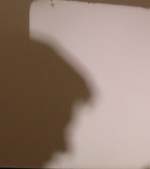
On one side of the encircled paper is a drawing of a bird, and on the other side there is a cage. With a very quick rolling around the horizontal axis one gets impression that the bird is in the cage. I used to create this kind of toys when I was a kid and yesterday, inpired by the elections for president in France, I did one again.
This optical illusion synthesizes two static pictures into a new one on a characteristic of human eye, which is called a retinal persistency (in english I found it under the persistence of a vision). The fact is that the retina in human eye retains the picture for a brief moment. So, in the case of our thaumatrop, the bird stayes on the retina long enough that when we "catch" the next one, is already replaced by the cage. This effect is used in cinema theaters, where the film is projected 24 (or 25) pictures per second and after each picture it comes a moment of black (shutter effect). TV uses the same effect in a bit different way, instead of one picture having two half pictures. The fact that the cinema (even the most realistic stories) is a big illusion, can't be more true.
J.J.B.

3 comments:
Nicely put in words and video.
Apperentely when we're watching a film in cinema we're watching most of the time in a total darkness.
B5
@B5
not most of the time but exactly two or three times (depends from the shutter)for each frame, there iare some moments of complete darkness.
J.J.B.
Post a Comment